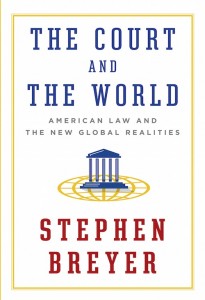 Should our Supreme Court be a pragmatic, flexible, problem-solving institution or should it continue to rely on the distant past to address today’s challenges?
Should our Supreme Court be a pragmatic, flexible, problem-solving institution or should it continue to rely on the distant past to address today’s challenges?
Stephen Breyer, perhaps our most articulate and thoughtful Supreme Court Justice, discusses in his latest study “the new challenges imposed by an ever more interdependent world,” asking how we should “interpret” our 18h century Constitution in the 21st century. He is both concise and compelling on the general themes of the rule of law and “the need for courts to listen to ‘many voices ‘. “
The judge suggests we discontinue our perpetual deification of the Declaration of Independence, Constitution, and its Bill of Rights, which may well have led to numerous serious mistakes: the ethnic cleansing of native Americans and war-mongering (citing the Mexican-American War, the Spanish-American War, the Vietnam War, and the Iraq War II, among others). Is, for example, our foreign policy, including going to war and security, solely the responsibility of the executive and legislative branches of government, and not the judiciary? Is this an outmoded 18th century idea?
Breyer goes on to dissect the “worst Court decisions in U. S. history:” Dred Scott (confirmation of slavery), Plessy vs. Ferguson(confirmation of state racial segregation), and Korematsu (approving the interning of Japanese-Americans). These show we require some external ideas to modify our domestic prejudices.
Since 1787 we’ve entered into many international agreements, such as the Geneva Convention, the United Nations, NATO, and the World Trade Organization. “In an intensely interdependent world facing global threats that are likely to last a generation or more (particularly terrorism), special security needs are no longer as intermittent or short-lived as they once were.” Our Afghanistan War is the longest in our history …
Add to this the growing complexity of international commerce: “ … the reality of modern-day commerce: national markets are now so interconnected and integrated that the most ordinary commercial transactions can involve a host of different activities and entities across the globe.” This leads to a “judicial need for information about foreign practices, rules, laws, and procedures.” We should try to stimulate the “laws of different nations” to “work together in harmony.” Better to argue than shoot each other.
Judge Breyer concludes, “Today’s Court should not base its answer to the kinds of questions illustrated here by reference solely (my italics) to the facts and conclusions of eighteenth century society.” The goal of the “rule of law” is to acknowledge that it is always in flux: “ … the rule of law prevents the opposite – namely the arbitrary, the autocratic, the despotic, the unreasonable, the dictatorial, the illegal, the unjust, and the tyrannical.” The reviewer in The New York Times had a succinct observation — “Democracy has never been a nativist straitjacket.”
History is the “sustained struggle against arbitrariness.” So the good judge gives us no conclusion. “There are no easy answers to this question.” We must continue “our conversations,” as our Court does.
A most thoughtful and stimulating read.
Editor’s Note: ‘The Court and the World’ by Stephen Breyer is published by Alfred A. Knopf, New York, 2015
 About the Author: Felix Kloman is a sailor, rower, husband, father, grandfather, retired management consultant and, above all, a curious reader and writer. He’s explored how we as human beings and organizations respond to ever-present uncertainty in two books, ‘Mumpsimus Revisited’ (2005) and ‘The Fantods of Risk’ (2008). A 20-year resident of Lyme, he now writes book reviews, mostly of non-fiction that explores our minds, our behavior, our politics and our history. But he does throw in a novel here and there. For more than 50 years, he’s put together the 17 syllables that comprise haiku, the traditional Japanese poetry, and now serves as the self-appointed “poet laureate” of Ashlawn Farms Coffee, where he may be seen on Friday mornings. His wife, Ann, is also a writer, but of mystery novels, all of which begin in a bubbling village in midcoast Maine, strangely reminiscent of the town she and her husband visit every summer.
About the Author: Felix Kloman is a sailor, rower, husband, father, grandfather, retired management consultant and, above all, a curious reader and writer. He’s explored how we as human beings and organizations respond to ever-present uncertainty in two books, ‘Mumpsimus Revisited’ (2005) and ‘The Fantods of Risk’ (2008). A 20-year resident of Lyme, he now writes book reviews, mostly of non-fiction that explores our minds, our behavior, our politics and our history. But he does throw in a novel here and there. For more than 50 years, he’s put together the 17 syllables that comprise haiku, the traditional Japanese poetry, and now serves as the self-appointed “poet laureate” of Ashlawn Farms Coffee, where he may be seen on Friday mornings. His wife, Ann, is also a writer, but of mystery novels, all of which begin in a bubbling village in midcoast Maine, strangely reminiscent of the town she and her husband visit every summer.